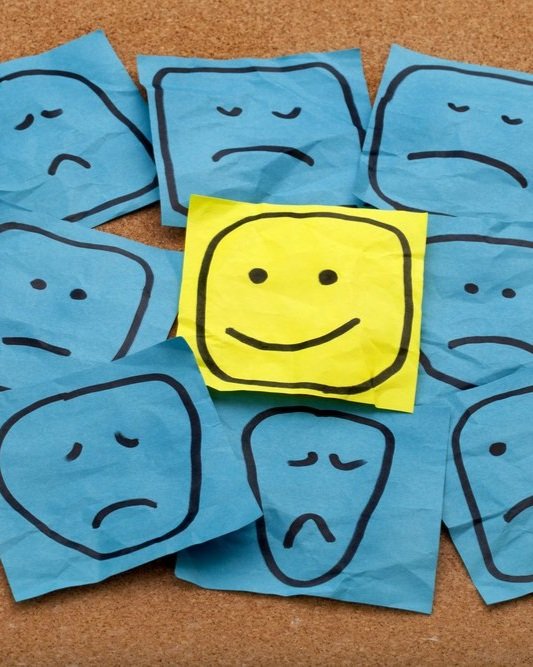What is happiness?
How often do you use a smiley face emoji to express your happiness? I must admit that I do it quite often… at least ten times a day, because it’s such an easy way to express my feelings and show gratitude. But these feelings of happiness are often fleeting; for example, when exchanging gossip with a friend, laughing at the latest cute cat meme, or eating my way through a packet of crisps.
Happiness is such an ambiguous term which can have a number of meanings. If a researcher were to ask you if you were happy… how would you respond? Have you ever actually taken time to sit down and think about your life, and whether or not you’re happy with the way things have turned out? Find yourself a quiet spot, and try it. Imagine that you’re the subject of a TV programme entitled ‘This is Your Life’. All of the main characters are there; your parents, siblings, partners and friends (past and present), and everything of major significance that has happened to you since birth is openly discussed.
Now imagine that you’re a member of the audience. How does it make you feel to see yourself from that perspective? What life roles have you played? Rebellious teenager? Student? Professional? Carer? Addict? Spouse/partner? Parent? Are they roles that you intentionally sought out for yourself – or did you just drift into them because it was easy, or what others expected of you? In which roles were you happiest?
One of the first people to practice this form of self-exploration was Greek philosopher Socrates in the 5th century BC. Credited as the founder of Western philosophy, he famously said “The unexamined life is not worth living.”
A brief history of happiness philosophies
His successors went on to conceptualize happiness as being composed of two very different characteristics;
Eudaimonia: regarded by Aristotle (384 - 322 BC) as a positive and divine state of being, achieved through a life of growth, virtue, and meaning, and
Hedonia: a very different philosophical outlook adopted by Aristippus (435 – 356 BC), of a life of pleasure-seeking, and the absence of distress.
Eudemonia and Hedonia are more commonly known today as meaning and pleasure respectively.
Some activities may be both pleasurable and meaningful, while others might skew more one way or the other. For example, volunteering for a cause you believe in might be more meaningful than pleasurable. Watching your favourite tv show on the other hand, might rank lower in meaning and higher on pleasure.
By the middle ages, the majority of thinkers and philosophers of the time such as Al-Ghazali (1058–1111), Maimonides (1135–1204) and Thomas Aquinas (1225 – 1274), all believed that happiness could only be achieved by devotion to God. It wasn’t until the 17th and 18th centuries, during the revolutionary developments in art, philosophy and politics known as the Enlightenment, that the idea that happiness matters not just to us as individuals, but to society as a whole, began to take root. In Great Britain, Scottish philosopher Frances Hutcheson (1694 – 1746), was the first to describe the best society as the one that had "the greatest happiness of the greatest number". Similar ideas were held by French and Italian reformers such as Montesquieu (1689 – 1755), Voltaire (1694 – 1778), and Beccaria (1738–1794), and in the New World by Thomas Jefferson (1743 – 1826) who drafted the classic phrases in the American Declaration of Independence about life, liberty and the pursuit of happiness.
The psychology of happiness
For the most part, the majority of psychology research has until recently, focused on analysing the negative aspects of our personalities and trying to cure dysfunction, rather than on trying to identify what makes us happy.
Things started to change in the 1950’s, when Humanistic psychologists theorised that we all have the power to overcome barriers to happiness within ourselves, and to achieve our full potential. Maslow's ‘Hierarchy of Needs’ is probably the best known of these, and proposes that once our basic needs are fulfilled such as having food, shelter, and safety, we’re motivated to satisfy our psychological and emotional needs, the highest of which is our need to achieve our full potential, also known as self-actualization. He believed that having the ability to focus on satisfying our higher needs is an important factor in why self-actualizing people are happier than others.
Research conducted by contemporary psychologists Ed Diener and Louis Tay in the early 2000’s, found that although the fulfilment of needs as defined by Maslow, does appear to be important to individual happiness in cultures across the world, the order in which the needs are met, has little bearing on how much they contribute to life satisfaction and enjoyment. This may be why people in impoverished nations, with only modest control over whether their basic needs are fulfilled, can nevertheless find a measure of well-being through social relationships, spiritualism, and self-actualisation, over which they have more influence.
They also found that people have higher life evaluations when they live in a society with others who have their needs fulfilled. It appears that improving one’s own life is not enough; society-wide improvement is also required. Read their report here.
This is a belief shared by psychologist Martin Seligman. Building on the work of the Humanists, he introduced a new approach called Positive Psychology during his presidency of the American Psychological Association in the 1990’s. Focusing on people’s unique strengths and virtues rather than on their weaknesses; helping them to discover value within themselves, to enhance not only their own lives, but those of others too.
You can find more information about Positive Psychology here.
Measuring happiness – subjective well-being
The aforementioned Ed Diener was the first to use the expression ‘subjective well-being’ (SWB) back in 1984 when he developed his tripartite happiness measurement tool. He theorised that happiness is subjective, because people themselves are the best judge of whether in fact they’re happy or not. It’s based on the ‘Hedonic’ happiness model, and entails both cognitive judgments of satisfaction, and affective evaluations of moods and emotions, and consists of these three components:
Life satisfaction
The presence of a positive mood
The absence of a negative mood
Measuring happiness – psychological well-being
A few years later, psychologist Carol Ryff developed a model of ‘Eudaimonic’ happiness, comprising six key challenges that individuals encounter as they strive to function positively;
Self-acceptance
Environmental mastery
Positive relationships
Personal growth
Purpose in life
Autonomy
Whereas the SWB model expresses well-being in terms of overall life satisfaction and happiness, the psychological well-being (PWB) model draws heavily on human development, and what it means to be psychologically healthy.
The science of happiness
There is virtually no dispute among scholars that our happiness is determined by three major factors:
A genetically determined set point for happiness
Life circumstances e.g. education, health, marital status, job, income etc.
The activities and practices that we engage in
A survey of the literature suggests that the genetically determined set point accounts for about 50% of our happiness, life circumstances account for only 10%, and intentional activities are responsible for the remaining 40%. Find more information here.
The set point
Having a genetic component to our set point for happiness as a consequence of our disposition and personality characteristics, doesn’t mean that we’re doomed to a miserable life if we’re a victim of the genetic happiness lottery. After all, only around half of the individual differences in happiness are accounted for by genetic influences. However, there are three personality types that are strongly and consistently related to happiness that we should be aware of.
Of the Big Five Personality Traits (extraversion, neuroticism, conscientiousness, openness to experience, and agreeableness), numerous studies have shown that extraversion and conscientiousness predict positive effect on happiness, whereas neuroticism is an exceptionally strong predictor of negative effect on both SWB and PWB.
According to these set-point theories, major life events such as the birth of a child or the death of a partner have only a temporary effect on the person’s happiness level, after which it reverts to the default level determined by genetic traits. Studies have shown that lottery winners tend to be not much happier, and that paraplegics tend to be not much unhappier, than a control group following an initial adjustment period.
Life circumstances
It was a surprise to me to discover that life circumstances such as our education, health, marital status, job, and income, account for only around 10% of our happiness. Our Western culture emphasizes these external routes to happiness, and of course, they’re important. However, think of all the famous people who have ‘had it all’ but have been so unhappy that they’ve taken their own life. Have you ever wondered why someone with more money, popularity, and success than you or I will ever have, would do that?
What has become apparent during my research, is that we can’t depend exclusively upon these external routes, and that we need to develop our internally centred values to be truly happy.
Activities and practices
In theory, finding internal routes to happiness should be easy because we’re the one in control of our thoughts, feelings, and behaviours… and yet, following through on happiness-increasing strategies may require concerted, consistent commitment and effort if we’re to achieve our goals. Most of us will at some time or another have made a New Year’s resolution to get fit/eat less/stop smoking etc., but how long did it last? It’s not just a lack of motivation or self-control. Most of us simply can’t bring about significant change in our lives without first understanding why we operate the way we do. Once we understand more intimately our mindset, values, beliefs, habits and fears, we’ll begin to realise why certain goals are going to be very hard for us to achieve, and even harder to maintain, unless we commit to a deeper level of change.
Nevertheless, changing our activities and practices offers us the best prospect for increasing and sustaining our happiness, because despite the difficulties, we have greater potential control over them than over our ‘set point’ and ‘life circumstances’ happiness routes.
Thank you for reading this blog post. I hope you’ve found it useful. If you have any thoughts to share, or ideas for future posts, please do let me know. I would love to hear from you.



